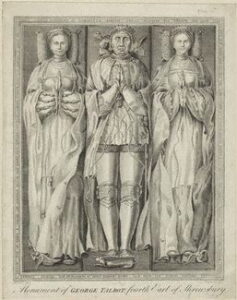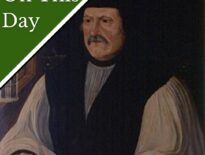On this day in Tudor history, 27th March 1539, George Talbot, 4th Earl of Shrewsbury, was laid to rest in the Shrewsbury Chapel of St Peter's Church, Sheffield.
Talbot is known for his loyalty to the king during the Pilgrimage of Grace uprisings, which was seen as crucial to the failure of the rebellion.
But let me tell you a bit more about this Tudor earl…
- George Talbot, 4th Earl of Shrewsbury, was born in Shifnal in Shropshire in 1468 and was the son and heir of John Talbot, 3rd Earl of Shrewsbury, and his wife, Katherine Stafford.
- His father died in 1473, when Talbot was just five, so the wardship of the young new Earl of Shrewsbury was granted to William, Baron Hastings, who arranged the marriage of Talbot to his daughter, Anne. They went on to have around 11 children, but only one surviving son, Francis, who became the 5th Earl of Shrewsbury, and three surviving daughters: Margaret, who married Henry Clifford, Earl of Cumberland; Mary, who had an unhappy marriage with Anne Boleyn’s former sweetheart, Henry Percy, 6th Earl of Northumberland, and Elizabeth, who married William, 3rd Baron Dacre of Gilsland.
- In 1487, Talbot served King Henry VII at the Battle of Stoke Field, known as the last battle of the Wars of the Roses, and was made a Knight of the Garter. He also served the king in the French campaign of 1492.
- In 1502, Talbot was made Lord Steward of the Household.
- Following the accession of the young King Henry VIII, Talbot was made Chamberlain of the Exchequer and was also sent on several diplomatic missions.
- The French kings Louis XII and Francis I granted him pensions.
- In 1512, following the death of his first wife, Talbot married Elizabeth Walden, daughter of Sir Richard Walden of Erith in Kent. They had a daughter together named Anne, who married Peter Compton, son of Henry VIII’s groom of the stool, William Compton, and then William Herbert, 1st Earl of Pembroke.
- Talbot served as Lieutenant of the Vanguard in the 1513 French campaign and Lieutenant-General in 1522 in the Scottish borders, and again in 1532.
- In October 1536, when the Pilgrimage of Grace rebellion broke out in Lincolnshire, in just a week Talbot was able to raise well over 3000 men on horseback to help put down the rebellion. The threat of his force was a factor in the rebels of Lincoln disbanding after hearing a royal proclamation. When further rebellion broke out in Yorkshire, Talbot and his men marched north to prevent Doncaster from being captured by the rebels. Talbot joined up with Norfolk but they were outnumbered by the rebels and so had to negotiate. However, as historian G W Bernard notes, “Shrewsbury's actions halted the momentum of the rising”, and prevented them marching south, because his influence spread from Sheffield down through Derbyshire and Nottinghamshire. Bernard goes as far to say that “It is scarcely an exaggeration to say that in October 1536 the fate of Henry VIII lay in the hands of the fourth earl of Shrewsbury”.
- Shrewsbury was a conservative Catholic and was not a supporter of Anne Boleyn. His son, Francis, attended her coronation in place of him.
- His rewards in Henry VIII’s reign included the stewardship of Tutbury and lands in Staffordshire and Derbyshire that were part of the duchy of Lancaster estates. He also owned Sheffield Manor, one of the places Cardinal Wolsey stayed at when he was travelling to London in 1530 to answer charges of treason.
- Talbot died on 26th July 1538 at Wingfield, but wasn’t buried until 27th March 1539, when he was laid to rest in the Shrewsbury Chapel of St Peter’s Church in Sheffield, which is now the cathedral.
Also on this day in Tudor history...




On the opening of his tomb 10 years ago, his body wasn’t there.? As a descendent I was asked if I had any idea. A lot of the talbot are buried in St Mary’s Church in ingerstery, stafford. But not sure if he’s there.